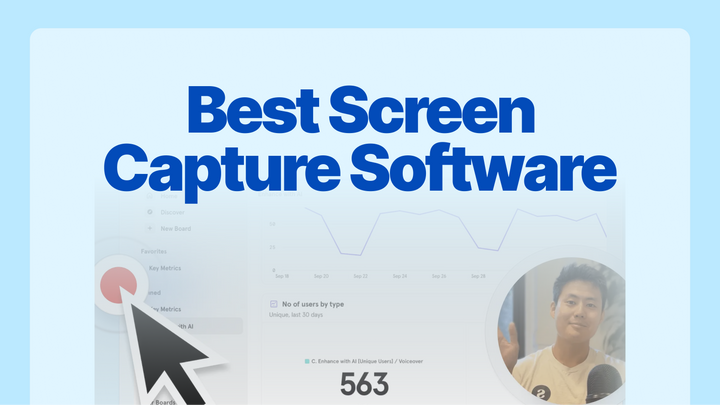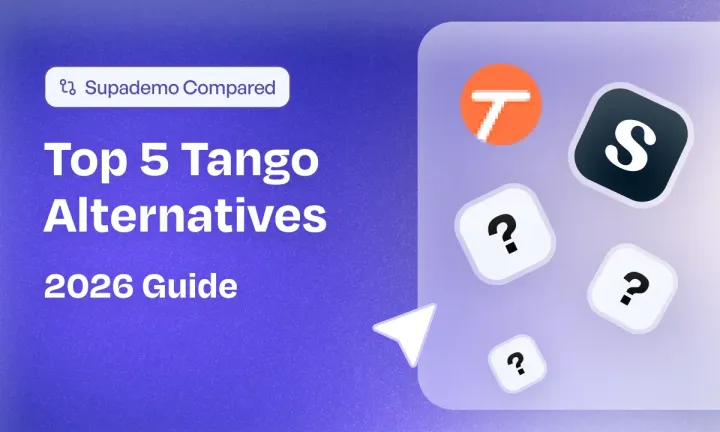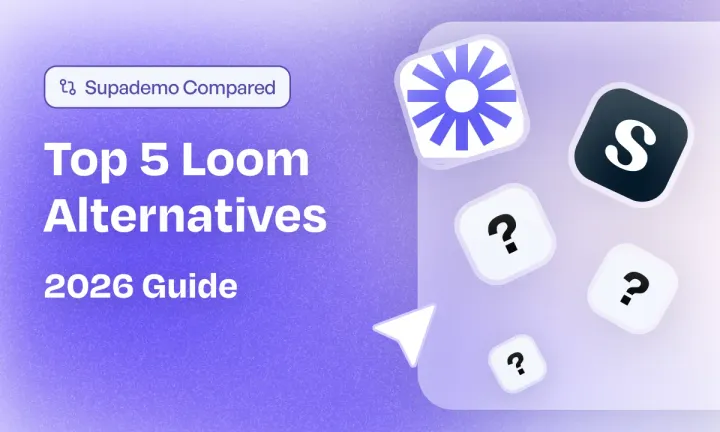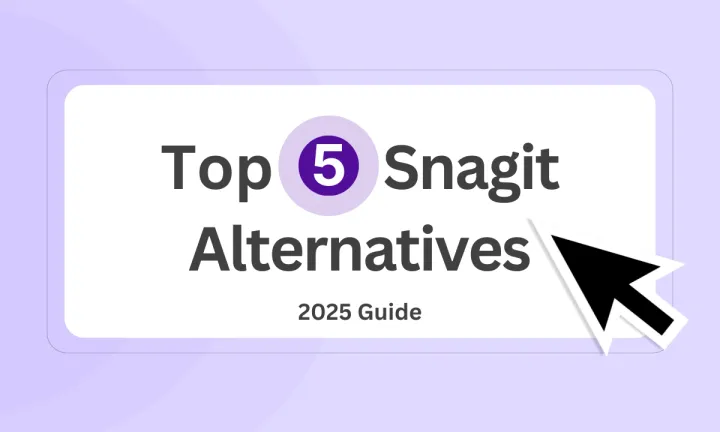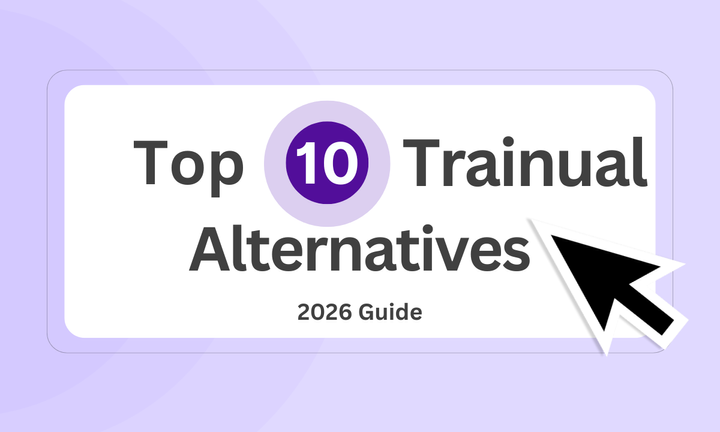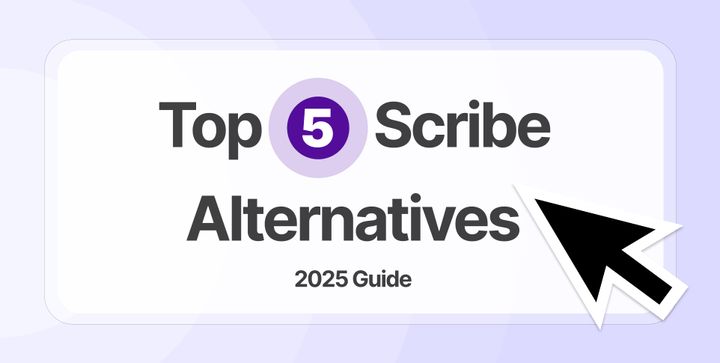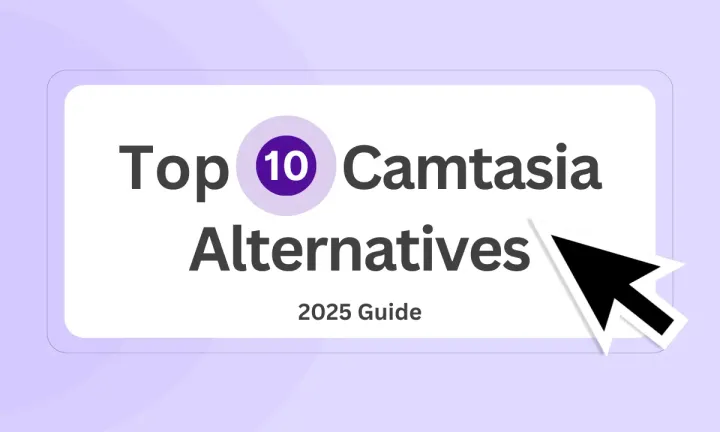A picture may be worth a thousand words, but a video is worth a thousand emails.
Screen capture software has become a must-have tool for teams that communicate complex ideas, demonstrate products, or troubleshoot issues quickly and effectively.
- Sales reps can record quick demos to show prospects how a product works.
- Customer success managers can create annotated walkthroughs to resolve issues faster.
- Product teams can document workflows and onboard new users with ease.
The result? Faster resolutions, happier customers, and more time back in your day.
According to a 2023 report by Wyzowl, 91% of businesses use video to communicate with customers. Whether you’re crafting product demos, onboarding new users, or providing technical support, screen recording apps empower you to show, not tell.
Suppose you’re a B2B sales professional, sales engineer, or GTM leader. This guide is your roadmap to finding the right screen capture software. We’ve broken down each tool’s strengths, pricing, and ideal use cases—so you can stop guessing and create impactful, client-facing content that drives results.
✅ Product-led growth (PLG) companies: Create self-serve demos and onboarding tutorials.
✅ Sales-led growth (SLG) teams: Craft personalized pitches and follow-ups that close deals faster.
✅ Customer success teams: Simplify support with visual, step-by-step walkthroughs.
TL;DR
Go directly to the list of the 10 best screen recording software of 2025.
• Best for quick recordings: Loom
• Best for polished videos: Screen Studio
• Best for AI-powered editing: Tella
• Best for podcasters: Riverside
• Best for professional editing: ScreenFlow
How to record your screen on your desktop?
Here’s a quick rundown:
How to record your screen on Windows
- Press
Windows + Gto open the Xbox Game Bar. - Click the “Capture” widget and select the record button.
- Click the “Stop” button or press
Windows + Alt + Rto stop. - Your recording will be saved in the “Videos/Captures” folder.
How to record your screen on Mac
- Press
Shift + Command + 5to open the Screenshot toolbar. - Select “Record Entire Screen” or “Record Selected Portion.”
- Click “Record” to start and “Stop” in the menu bar to end.
- The recording will save to your desktop by default.
How to record your screen on your mobile?
Here’s a step-by-step tutorial:
How to record your screen on an iPhone
- Add Screen Recording to Control Center via Settings > Control Center.
- Swipe down to open Control Center and tap the Record icon.
- Wait for the countdown to start.
- To stop, tap the red Record button or the red status bar.
- The recording will save to your Photos app.
How to record your screen on Android
- Swipe down to open Quick Settings.
- Tap the Screen Record option (edit Quick Settings if needed).
- Choose your recording area and audio options.
- Tap Start to begin recording.
- To stop, tap the Screen Recorder notification.
- The recording will save to your Photos or Gallery app.
For more advanced editing features, explore a tool like Supademo to capture a video of your desktop, webcam, or both directly—no login, download, or installation required. Whether you're creating a quick, one-off screen recording for internal communications or adding a personalized intro slide, the webcam and desktop screen recorder is easy to use, as demonstrated below:
What makes a good screen recorder?
Choosing the right screen recorder isn’t just about hitting the record button—it’s about finding a tool that fits seamlessly into your workflow and delivers professional results. Here’s what to look for:
1. Capture methods and region types
A great screen recorder offers flexibility in how and what you capture. Whether you need to record your entire screen, a specific application, or a custom region, the tool should adapt to your needs. Look for options like:
- Full-screen, window, or region capture for precision.
- Picture-in-picture recording to include webcam footage alongside your screen.
- Screen and sound synchronization to ensure your audio matches your visuals perfectly.
2. Annotation and real-time editing tools
Why wait until after recording to make edits? The best screen recorders let you annotate, highlight, or trim clips while recording. Features like:
- On-screen drawing tools (arrows, shapes, text).
- Real-time editing to cut out mistakes without starting over.
- Multiple output formats (MP4, GIF, etc.) for compatibility with different platforms.
3. Upload and sharing options
Once your recording is ready, you need to share it quickly and securely. Look for tools that offer:
- Instant sharing via links or email.
- Cloud video hosting for easy access and collaboration.
- Local saving options for offline use or backup.
4. Productivity and business features
For teams, a screen recorder should do more than just record—it should enhance productivity. Key features include:
- Enterprise-grade security to protect sensitive data.
- Content management for organizing and retrieving recordings.
- Deep analytics to track video performance and engagement.
- Access control to manage who can view or edit recordings.
5. Simplicity and reliability
An excellent screen recorder shouldn’t require a manual to use. Look for:
- A simple, intuitive interface that anyone can navigate.
- No-lag recording for smooth, professional-quality videos.
- Offline recording capabilities for uninterrupted work.
Creating a screen recording is just the beginning—what happens after you hit “stop” is equally important. The quality of your final video can make or break its effectiveness, which is why we also emphasize the importance of post-recording editing tools and features.
10 best screen recording software in 2025
When putting together this list, we focused on video recording software popular among B2B PLG and SLG companies. We also considered sales leaders, GTM teams, and marketing professionals. These roles rely on clear, impactful communication to drive outreach, conversions, and overall business growth. For them, having the right screen recorder isn’t just a convenience—it’s a necessity.
| Screen Capture Software | Features | Pricing | Ease | G2 Rating |
|---|---|---|---|---|
| Supademo | ⭐⭐⭐⭐ | ⭐⭐⭐ | ⭐⭐⭐⭐⭐ | 4.8 |
| Loom | ⭐⭐⭐⭐ | ⭐⭐⭐ | ⭐⭐⭐⭐⭐ | 4.7 |
| Screen Studio | ⭐⭐⭐⭐ | ⭐⭐⭐ | ⭐⭐⭐⭐ | - |
| Cap | ⭐⭐⭐ | ⭐⭐⭐⭐⭐ | ⭐⭐⭐⭐⭐ | - |
| Snagit | ⭐⭐⭐ | ⭐⭐ | ⭐⭐⭐ | 4.7 |
| Tella | ⭐⭐⭐ | ⭐⭐⭐⭐ | ⭐⭐⭐⭐ | - |
| ScreenPal | ⭐⭐⭐ | ⭐⭐⭐⭐ | ⭐⭐⭐⭐ | 4.4 |
| Riverside | ⭐⭐⭐⭐⭐ | ⭐⭐ | ⭐⭐ | 4.8 |
| ScreenFlow | ⭐⭐⭐⭐⭐ | ⭐⭐ | ⭐⭐ | 4.5 |
| OBS Studio | ⭐⭐⭐⭐ | ⭐⭐⭐ | ⭐⭐⭐ | 4.7 |
1. Supademo
Supademo brings together interactive walkthroughs, screenshots, and video recording in one platform, making it a strong choice for teams that want to avoid juggling separate tools. The real advantage lies in the platform's interactivity, with clickable hotspots, personalized variables, and guided steps that turn static content into engaging, trackable experiences.
What are Supademo’s features?
- Screen recording: Supademo lets you record your screen, camera, or both right from the Chrome extension. You can make quick edits like trimming or muting, then save as a video or instantly convert it into a shareable, trackable Supademo.
- Interactive hotspots: Hotspots can highlight key features, provide additional context, or guide users step-by-step through a workflow. They are handy for onboarding new users or showcasing specific functionalities. You can add clickable elements to guide users through your product.
- Dynamic variables: Dynamic variables allow you to tailor demos to individual users, making the experience more engaging and relevant. For example, you can insert a prospect’s name, company, or other personalized details directly into the demo.
- Analytics: Supademo’s analytics provide actionable insights into how users interact with your demos. You can track engagement metrics like clicks, views, and completion rates. Use this data to identify drop-off points, optimize content, and improve user engagement.
- Custom branding: With custom branding, you can ensure that your demos align with your brand identity, including colors, logos, and fonts. This creates a cohesive experience for your audience and reinforces brand recognition.
- Chrome extension updates: The updated Chrome extension now handles click events more efficiently, reduces refresh prompts, and ensures a smoother recording experience.
- Higher video upload limit for Scale customers: Scale customers can now upload videos up to 150MB, allowing for longer and more detailed demos.
- AI-powered features: Supademo's annotation generator offers several AI-powered features, including AI voiceovers, AI-generated annotations, and AI translations, to make screen recordings more engaging.
What is Supademo’s pricing?
- Free ($0/creator/month): Includes 5 Supademos, unlimited screenshots, basic editor, link or embed sharing, video/SOP export, and an in-app demo hub.
- Pro ($27/creator/month): Adds unlimited Supademos, team workspace, zoom & autoplay, custom branding, blur/annotations, demo analytics, and AI generation.
- Scale ($38/creator/month): Includes everything in Pro plus dynamic variables, trackable links, branching, password protection, custom domains, insights, commenting, and integrations.
- Growth ($350/month): Covers 5 creators, unlimited HTML Supademos, editable captures, sandbox demos, AI voice cloning, white-glove onboarding, and unlimited view-only members.
- Enterprise (Custom): Adds multiple workspaces, SSO/SAML, dedicated support, custom data retention, audits, and custom data residency for advanced security and control.
What are Supademo’s pros & cons?
✅ Combines interactive demos, screenshots, and videos in one platform.
✅ Great for personalized onboarding and training.
✅ Robust analytics for tracking performance.
❌ Not available in the desktop app.
❌ Requires an internet connection for creation.
Should you use Supademo for screen recording?
Supademo is ideal for customer success, sales, and GTM teams that need more than a basic screen recorder. By combining demos, screenshots, and video recording in one tool, it’s a compelling alternative for anyone tired of switching between multiple platforms.
2. Loom
Loom is a household name in screen recording, known for its simplicity and speed. It’s perfect for teams that want to record, share, and collaborate on videos without a steep learning curve.
What are Loom’s features?
- Screen + webcam recording: Record your screen with a picture-in-picture overlay for a personal touch.
- Instant sharing: Share videos via links, embed them in emails or integrate them with tools like Slack and Salesforce.
- AI-powered editing: Automatically remove filler words, generate transcripts, and add chapters for better accessibility.
- Viewer insights: Track who watched your videos and how long they engaged.
What is Loom’s pricing?
Read our in-depth analysis on Loom's pricing.
- Starter: Free (25 videos, 5-minute limit).
- Business: $18/user/month (unlimited videos, custom branding).
- Enterprise: Custom pricing (advanced security, SSO).
What are Loom’s pros & cons?
✅ Easy to use and share videos instantly.
✅ Great for asynchronous communication.
✅ The free plan is generous for small teams.
❌ Limited editing capabilities.
❌ No advanced interactivity features.
Should you use Loom for screen recording?
Loom is ideal for teams that need a no-frills tool for quick recordings and sharing. However, you should explore other options for advanced editing or interactivity.
3. Screen Studio
Screen Studio is a macOS-exclusive tool that delivers studio-quality recordings with smooth zooms, transitions, and animations.
What are Screen Studio’s features?
- Automatic zoom: Highlights key actions with smooth zooms.
- Cursor effects: Transforms shaky cursor movements into smooth glides.
- Custom branding: Add logos, backgrounds, and shadows.
- Multi-track editing: Combine screen recordings, webcam footage, and audio.
What is Screen Studio’s pricing?
- Subscription: $29/month.
- Perpetual license: $229 (one-time payment).
What are Screen Studio’s pros & cons?
✅ High-quality outputs with minimal effort.
✅ Intuitive interface for beginners.
✅ Frequent updates and new features.
❌ Screen recorder for Mac only—no Windows support.
❌ No analytics or interactivity features.
Should you use Screen Studio for screen recording?
Screen Studio is perfect for Mac users who want professional-looking recordings without spending hours editing.
4. Cap
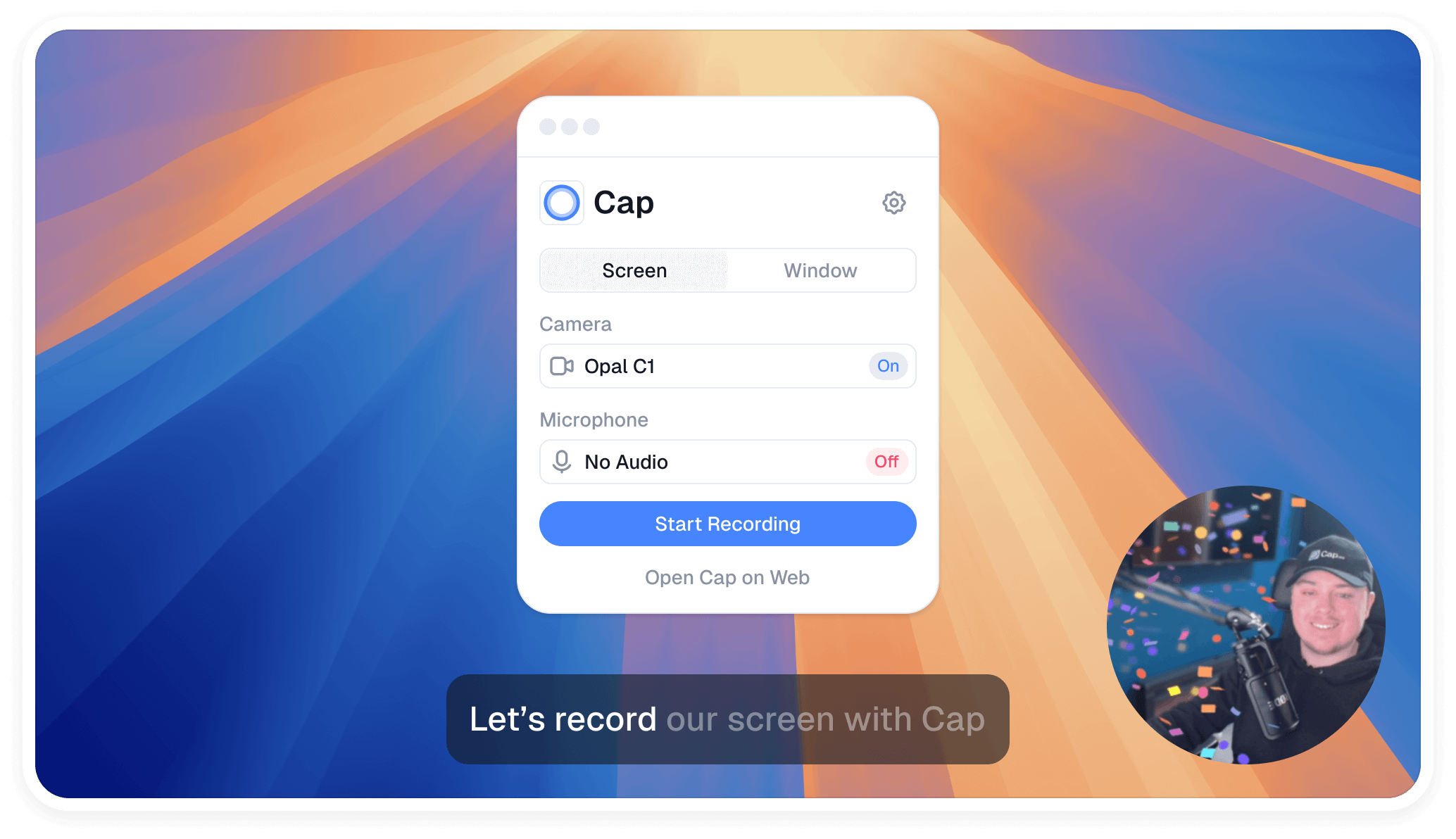
Cap’s affordability and ease of use make it a strong competitor for creating simple step-by-step tutorials.
What are Cap’s key features?
- Screen and window recording: Effortlessly record your screen or specific windows, perfect for step-by-step video tutorial creation.
- Local video export: Save videos locally for additional editing or offline sharing, giving you complete control over your content.
- Powerful video editor: Customize tutorials with gradients, transitions, and annotations to create visually appealing, engaging content.
- Unlimited cloud storage and shareable links: Store videos securely in the cloud and easily share them using generated links.
- Password-protected videos: Secure your content with password protection, ensuring only authorized viewers can access your tutorials.
- Advanced analytics: Measure video engagement and viewer performance to refine and improve tutorial content over time.
What is Cap’s pricing?
- Cap Lite: Free (basic features, limited recordings).
- Cap Pro: $9/month (unlimited recordings, advanced features).
- Custom: Custom pricing for teams (advanced integrations, custom branding).
What are Cap’s pros & cons?
✅ Lightweight and intuitive interface, making it easy for users to create video tutorials quickly.
✅ Open-source, allowing developers to customize and adapt the tool to their specific needs.
✅ Privacy-first design: With a local-first approach, your recordings and edits happen locally, giving you complete control over your data and ensuring faster performance.
❌ Limited customization options compared to higher-end tools.
❌ Currently in beta—this could mean occasional bugs, limited support, and feature instability.
❌ macOS-only compatibility, limiting accessibility for Windows users.
❌ No interactive tutorial features, such as clickable hotspots or guided walkthroughs.
Should you use Cap for screen recording?
Cap’s intuitive design, open-source nature, privacy-first approach, and analytics make it perfect for straightforward instructional content. However, its beta status and lack of advanced interactive features might be limitations for some users.
5. Snagit
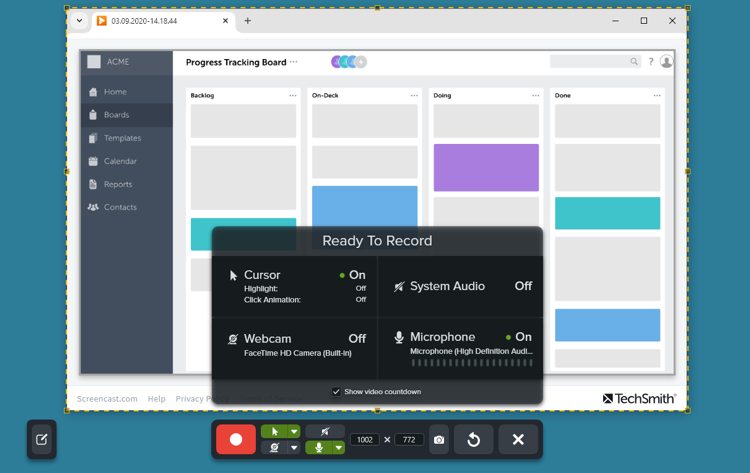
Snagit is a versatile tool that combines screen capture with basic video recording and annotation features. It’s great for creating quick tutorials and process documentation.
What are Snagit’s key features?
- Screen + webcam recording: Capture your screen with a webcam overlay.
- Annotation tools: Add arrows, text, and shapes to highlight key points.
- GIF creation: Turn screen recordings into shareable GIFs.
- Seamless sharing: Share directly to email, Slack, or cloud storage.
What is Snagit’s pricing?
- Individual subscription: $39/year.
- Perpetual license: $62.99 (one-time payment).
What are Snagit’s pros & cons?
✅ Easy to use with a low learning curve.
✅ Great for quick, simple recordings.
✅ Affordable pricing.
❌ Limited video editing capabilities.
❌ No advanced interactivity or analytics.
Should you use Snagit for screen recording?
Snagit is a solid choice for teams that need a straightforward tool for basic screen recordings and annotations.
6. Tella

Tella is designed for users who want to create polished videos quickly. It offers features like segmented recording and AI-powered editing.
What are Tella’s key features?
- Segmented recording: Record in parts to avoid mistakes.
- AI editing: Remove filler words and silences automatically.
- Custom branding: Add logos and colors to match your brand.
- Instant sharing: Share videos via links or embed them on websites.
What is Tella’s pricing?
- Pro: $19/user/month.
- Premium: $49/user/month (custom branding, analytics).
What are Tella’s pros & cons?
✅ Easy to use with a clean interface.
✅ AI-powered editing saves time.
✅ Great for quick, polished videos.
❌ Limited advanced editing features.
❌ No interactivity or analytics in lower tiers.
Should you use Tella for screen recording?
Tella is ideal for creators who want a simple, efficient tool for recording and editing videos without a steep learning curve.
7. ScreenPal
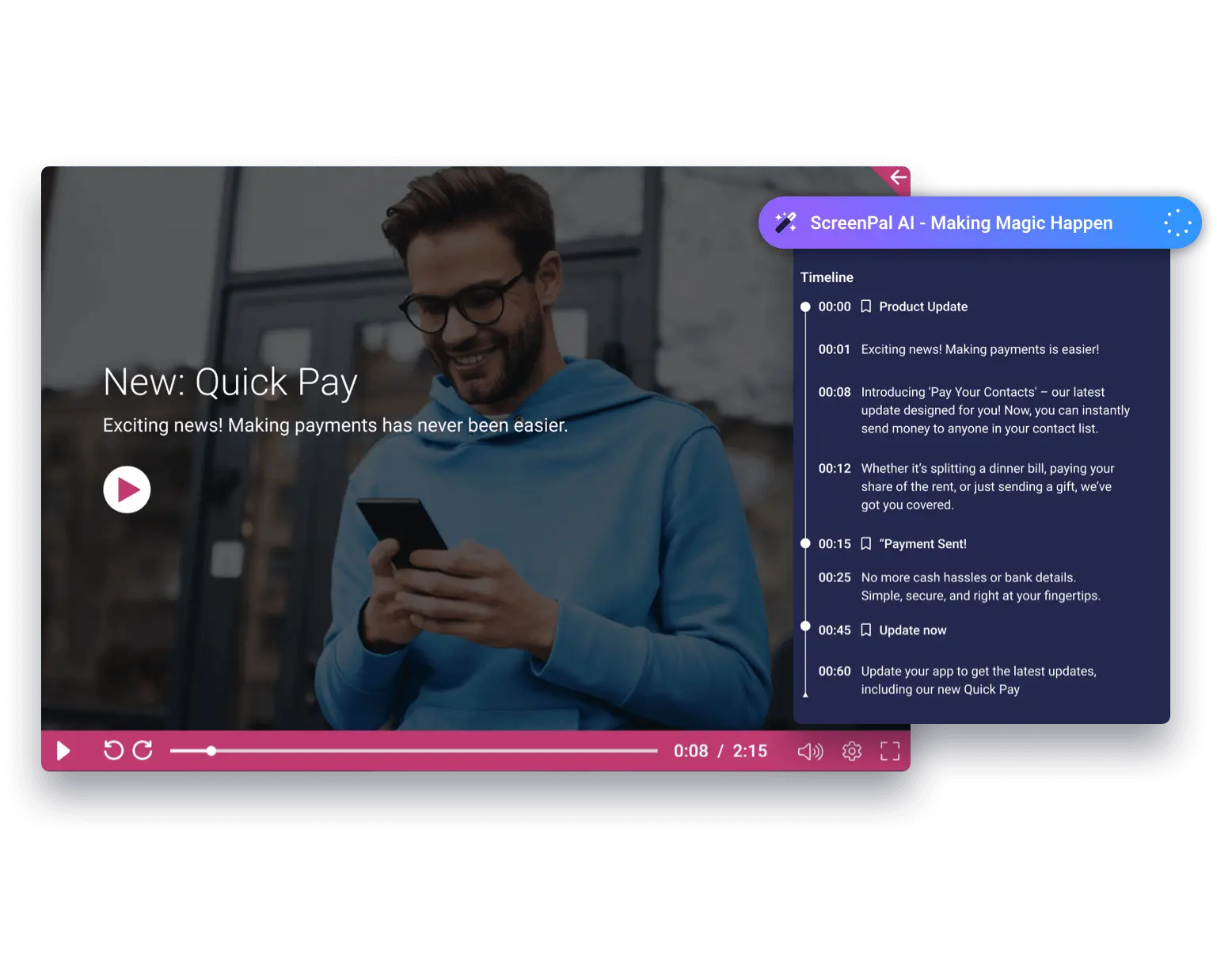
ScreenPal is a user-friendly screen recording tool for creating tutorials, training videos, and presentations.
What are ScreenPal’s key features?
- Screen + webcam recording: Capture your screen with a webcam overlay.
- Basic editing tools: Trim, cut, and add captions to your recordings.
- Cloud storage: Store and share videos directly from the cloud.
- Quizzing and interactivity: Add quizzes and interactive elements to your videos.
What is ScreenPal’s pricing?
- Free: Limited features, 15-minute recordings.
- Deluxe: $3/month (unlimited recordings, basic editing).
- Premier: $6/month (advanced editing, cloud storage).
What are ScreenPal’s pros & cons?
✅ Easy to use with a low learning curve.
✅ Great for educators and trainers.
✅ Affordable pricing.
❌ Limited advanced features.
❌ Free plan has significant restrictions.
Should you use ScreenPal for screen recording?
ScreenPal is a solid choice for educators and trainers who need a simple, affordable tool for creating instructional videos.
8. Riverside
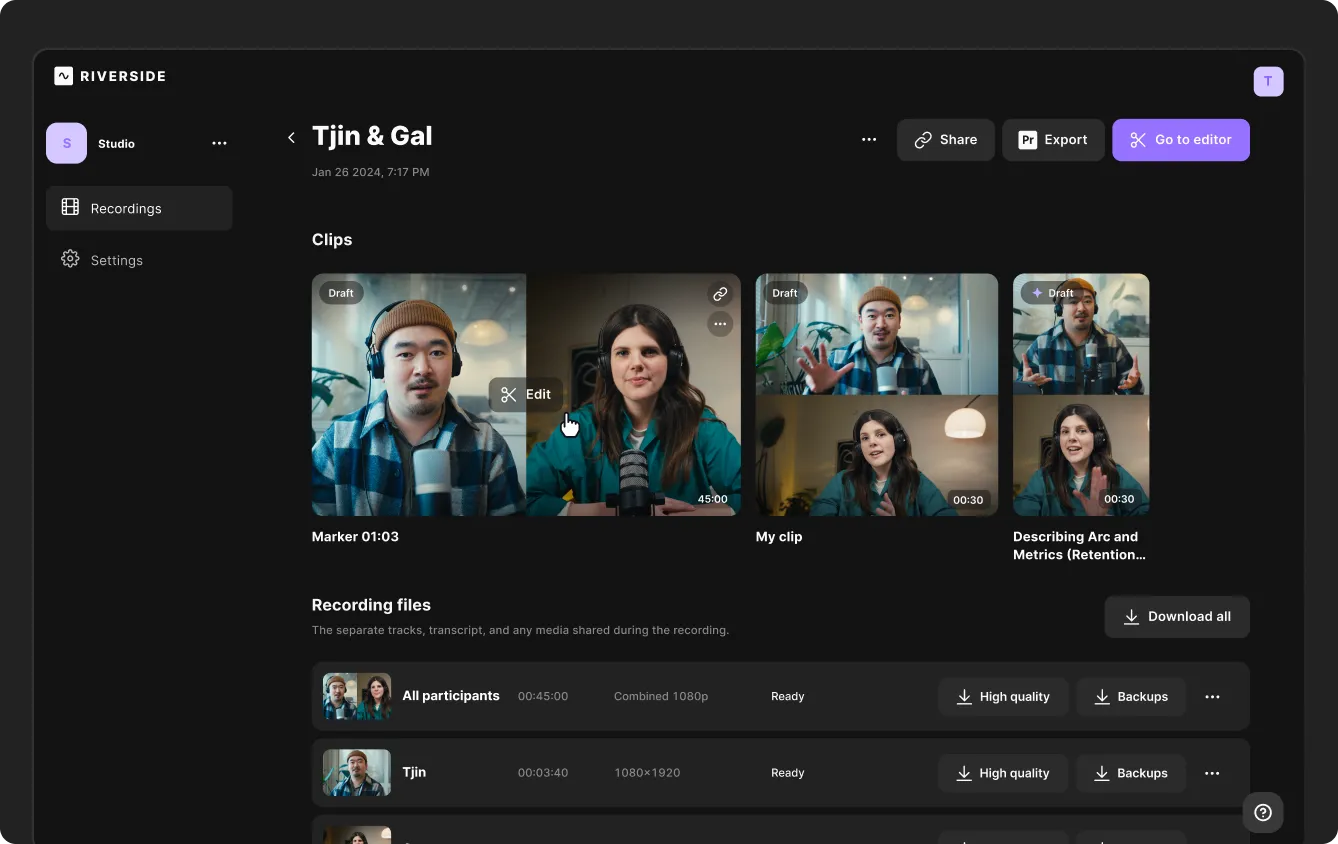
Riverside is a professional-grade tool that delivers high-quality audio and video recordings for podcasts and interviews.
What are Riverside’s key features?
- High-quality recordings: Record in 4K video and 48kHz audio.
- Separate tracks: Record each participant’s audio and video separately for better editing.
- Live streaming: Stream directly to platforms like YouTube and Facebook.
- Editing tools: Trim, cut, and add captions to your recordings.
What is Riverside’s pricing?
- Free: Limited features, 2 hours of recording.
- Standard: $19/month (5 hours of recording, 720p video).
- Pro: $29/month (15 hours of recording, 4K video).
What are Riverside’s pros & cons?
✅ High-quality audio and video recordings.
✅ Separate tracks for better editing.
✅ Great for podcasts and interviews.
❌ Expensive compared to other tools.
❌ Limited screen recording features.
Should you use Riverside for screen recording?
Riverside is perfect for podcasters and content creators who need high-quality audio and video recordings.
9. ScreenFlow
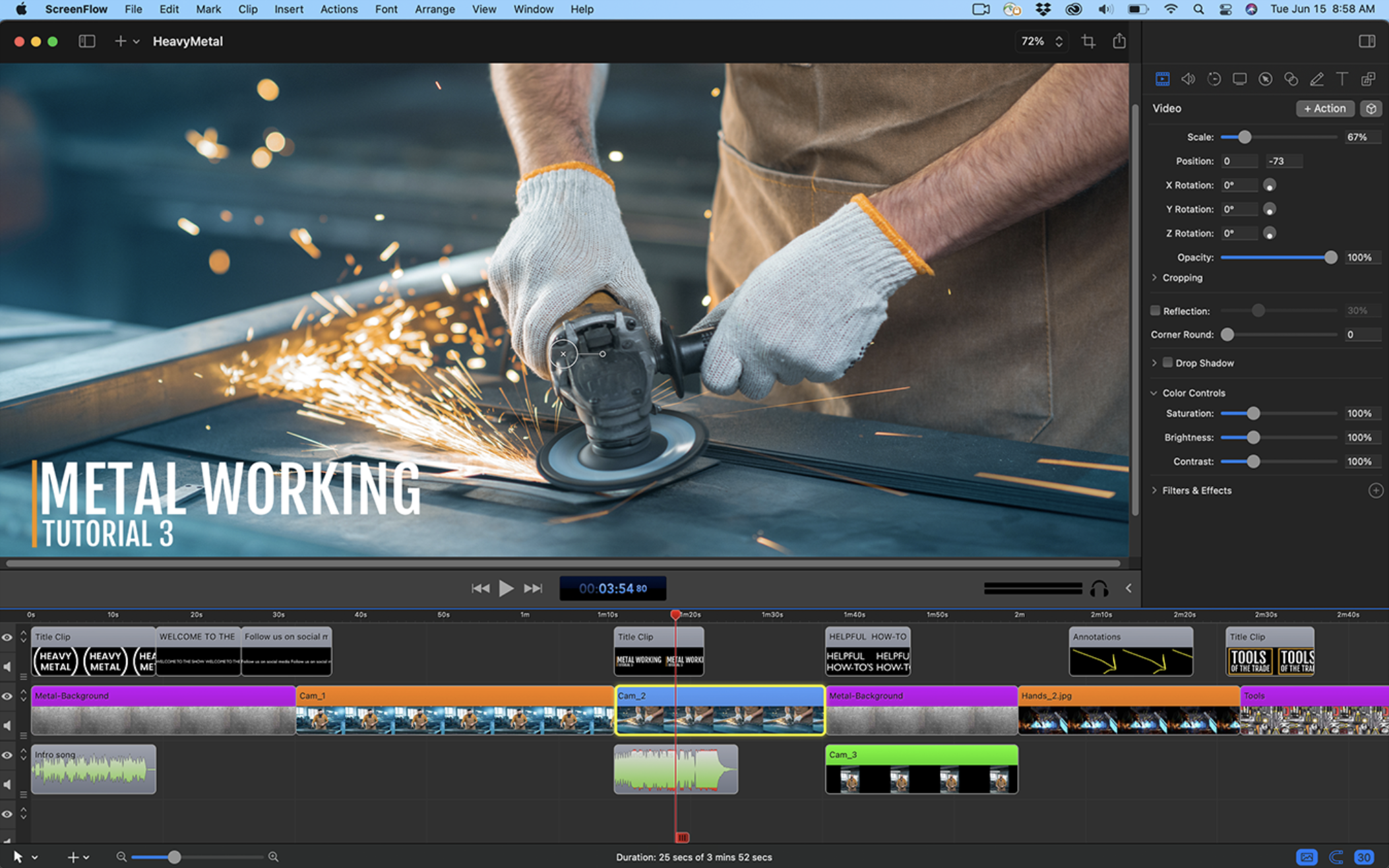
ScreenFlow is a powerful screen recording and video editing tool built for users who value precision and advanced editing tools. Its robust screen recording capabilities, multi-track editing, and professional video effects make it ideal for creating polished, step-by-step product demos. ScreenFlow’s interface bridges the gap between simplicity and professional-grade functionality.
What are ScreenFlow’s features?
- Simultaneous screen, camera, and mic recording: Record your screen, webcam, and audio simultaneously to create dynamic and engaging video tutorials.
- Customizable title library: Add professional-looking titles and text overlays with ease, elevating the quality of your video tutorials.
- Powerful video editing tools: Enhance video tutorials with transitions, text animations, freehand annotations, and multi-channel audio for a polished finish.
- Professional animations and motion graphics: Animate graphics, titles, and logos to add a professional touch and visual appeal to your videos.
- Closed caption support: Use ScreenFlow’s caption editor to create ADA-compliant subtitles, ensuring accessibility for a wider audience.
- Streamlined publishing options: Publish directly to platforms like YouTube, Vimeo, and Wistia for easy sharing and distribution of your tutorials.
What is ScreenFlow’s pricing?
- License: $169 (one-time fee for macOS).
What are ScreenFlow’s pros & cons?
✅ High-quality screen recording that captures detailed software demonstrations and tutorials.
✅ Multi-track editing with advanced editing tools for professional and detailed video tutorial creation.
✅ Audio editing features for voiceovers, sound adjustments, and multi-channel audio editing.
❌ While intuitive for beginners, mastering advanced features can take time due to its learning curve.
❌ ScreenFlow’s screen recording and editing processes can be demanding on system resources, requiring a high-performance Mac for smooth operation.
❌ The last update seems to be from October 2023. Also, users in Reddit & Facebook communities say that many support queries aren’t answered.
❌ No interactive tutorial features, such as clickable hotspots or guided walkthroughs.
Should you use ScreenFlow for screen recording?
ScreenFlow is a strong option for professionals and content creators who need advanced editing tools and high-quality screen recording to produce polished video tutorials. With features like multi-track editing, customizable titles, and professional animations, it’s well-suited for detailed, in-depth tutorial creation. However, the lack of recent updates, limited customer support, and lack of interactivity features may make it less appealing for users seeking a more modern or responsive solution.
10. OBS Studio
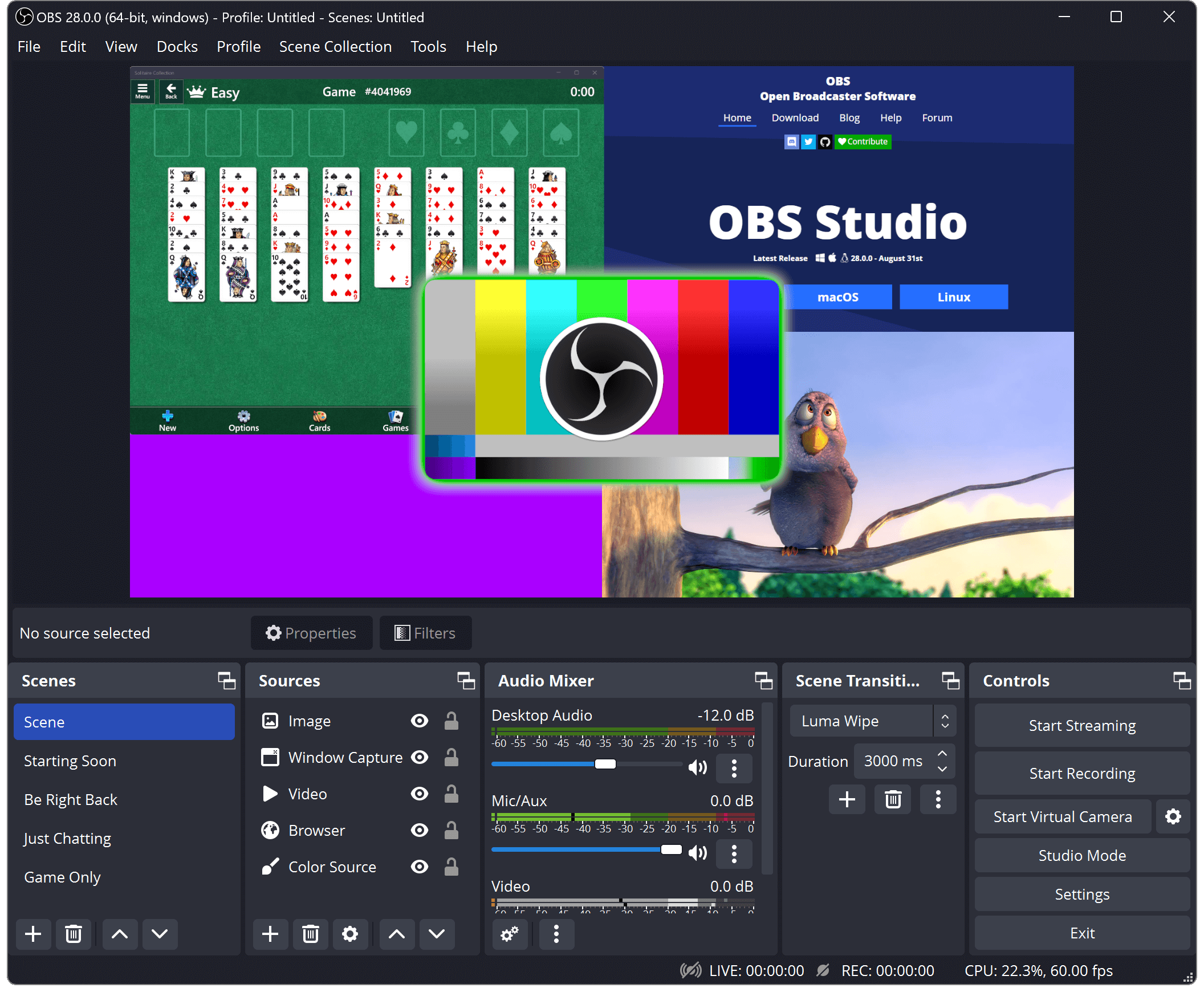
OBS Studio is a free, open-source tool offering unparalleled screen recording flexibility.
What are OBS Studio’s key features?
- Customizable recording settings: Adjust resolution, frame rate, and bitrate for high-quality screen recordings.
- Live streaming: Stream directly to platforms like YouTube, Twitch, and Facebook.
- Scene composition: Combine multiple sources like screen captures, webcam feeds, and images.
- Plugins and extensions: Enhanced functionality with a wide range of community-developed plugins.
What is OBS Studio’s pricing?
- Free: Open-source and completely free to use.
What are OBS Studio’s pros & cons?
✅ Highly customizable and flexible.
✅ Free and open-source.
✅ Great for live streaming.
❌ Steeper learning curve for beginners.
❌ No built-in editing tools.
Verdict:
OBS Studio is perfect for advanced users who need a powerful, customizable tool for screen recording and live streaming.
Comparison table of the top 10 screen capture software in 2025
| Tool | Best For | Pricing | Key Features | Pros | Cons |
|---|---|---|---|---|---|
| Supademo | Interactive demos & onboarding | Free - $36/creator/mo | Interactive hotspots, dynamic variables | Engaging, personalized, robust analytics | No video editing, internet required |
| Loom | Quick, asynchronous communication | Free - $18/user/month | Screen + webcam, AI editing, viewer insights | Easy to use, instant sharing | Limited editing, no interactivity |
| Screen Studio | High-quality, polished recordings | $29/month or $229/year | Automatic zoom, cursor effects, custom branding | Studio-quality outputs, intuitive | macOS only, no analytics |
| Cap | Affordable recordings | Free - $9/month | Screen + window recording, local export, cloud storage | Affordable, intuitive, privacy-first | Beta status, macOS only, no interactivity |
| Snagit | Simple screen captures & recordings | $39/year or $62.99/perpetual | Screen + webcam, annotation tools, GIF creation | Affordable, easy to use | Limited editing, no interactivity |
| Tella | Quick, AI-powered video creation | $19-49/user/month | Segmented recording, AI editing, custom branding | Simple, efficient, AI-powered | Limited advanced features |
| ScreenPal | Educators & trainers | Free - $6/month | Screen + webcam, basic editing, quizzing | Easy to use, affordable | Limited advanced features |
| Riverside | Podcasters & content creators | Free - $29/month | High-quality audio/video, separate tracks | Professional-grade recordings | Expensive, limited screen recording |
| ScreenFlow | Professional-quality tutorials | $169 (one-time) | Multi-track editing, animations, closed captions | Advanced editing, high-quality outputs | Expensive, resource-intensive, no interactivity |
| OBS Studio | Advanced users & live streamers | Free | Customizable settings, live streaming, plugins | Highly customizable, free | Steep learning curve, no editing |
Best screen recording software — where to start?
If you’re looking for screen capture software, the essentials are clear: the ability to record your screen, camera, or both, and take quick screenshots when needed. Supademo delivers on those basics, letting you capture high-quality recordings directly from its Chrome extension and quickly edit to clean up your videos before sharing.
Where Supademo truly stands out is in what you can do next. Alongside video recording, it lets you create interactive demos with clickable hotspots, guided steps, and personalized variables. That means the same tool you use for screen capture can also produce onboarding tutorials, sales walkthroughs, and training guides that actively engage your audience.
Give your team a single platform for screen capture and interactive walkthroughs. Start using Supademo today and create content that informs, engages, and converts.


